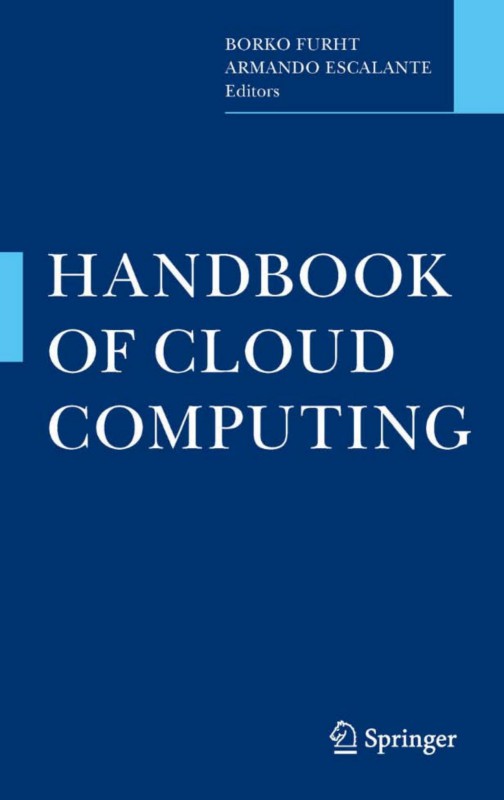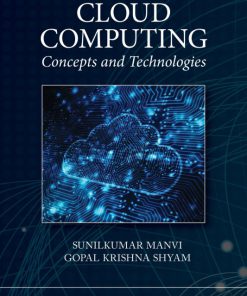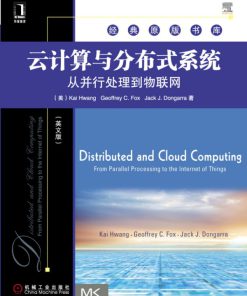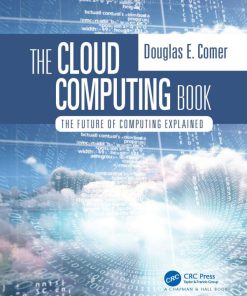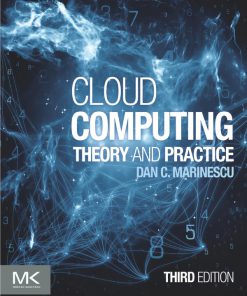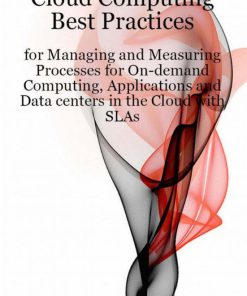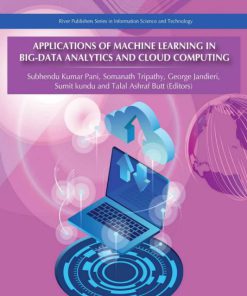Handbook of Cloud Computing 1st Edition by Borko Furht ISBN 9781441965233
$50.00 Original price was: $50.00.$25.00Current price is: $25.00.
Authors:Borko Furht, Armando Escalante , Tags:Springer; 9781441965233; 978-1-4419-6524-0 , Author sort:Borko Furht, Armando Escalante , Languages:Languages:eng , Published:Published:Jun 2012 , Comments:Comments:Springer
Handbook of Cloud Computing 1st Edition by Borko Furht – Ebook PDF Instant Download/Delivery. 9781441965233
Full download Handbook of Cloud Computing 1st Edition after payment
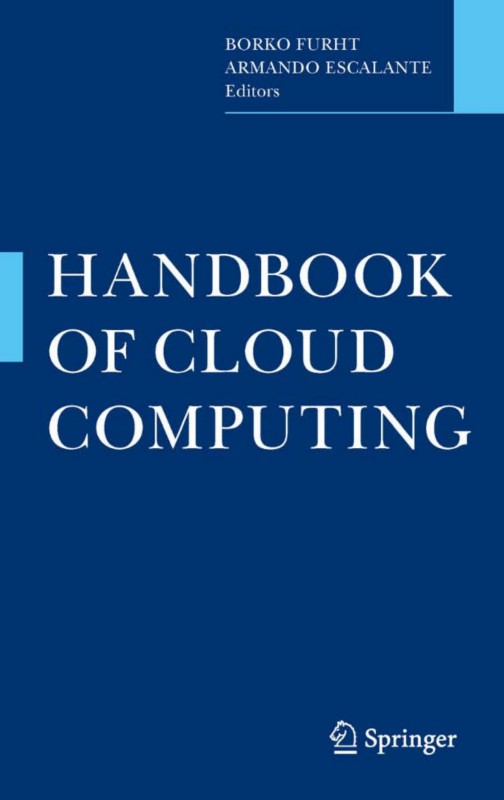
Product details:
ISBN 10:
ISBN 13: 9781441965233
Author: Borko Furht
Cloud computing has become a significant technology trend. Experts believe cloud computing is currently reshaping information technology and the IT marketplace. The advantages of using cloud computing include cost savings, speed to market, access to greater computing resources, high availability, and scalability. Handbook of Cloud Computing includes contributions from world experts in the field of cloud computing from academia, research laboratories and private industry. This book presents the systems, tools, and services of the leading providers of cloud computing; including Google, Yahoo, Amazon, IBM, and Microsoft. The basic concepts of cloud computing and cloud computing applications are also introduced. Current and future technologies applied in cloud computing are also discussed. Case studies, examples, and exercises are provided throughout. Handbook of Cloud Computing is intended for advanced-level students and researchers in computer science and electrical engineering as a reference book. This handbook is also beneficial to computer and system infrastructure designers, developers, business managers, entrepreneurs and investors within the cloud computing related industry.
Handbook of Cloud Computing 1st Table of contents:
Part I Technologies and Systems
1 Cloud Computing Fundamentals
1.1 Introduction
1.1.1 Layers of Cloud Computing
1.1.2 Types of Cloud Computing
1.1.3 Cloud Computing Versus Cloud Services
1.2 Enabling Technologies
1.2.1 Virtualization
1.2.2 Web Service and Service Oriented Architecture
1.2.3 Service Flow and Workflows
1.2.4 Web 2.0 and Mashup
1.3 Cloud Computing Features
1.3.1 Cloud Computing Standards
1.3.2 Cloud Computing Security
1.4 Cloud Computing Platforms
1.4.1 Pricing
1.4.2 Cloud Computing Components and Their Vendors
1.5 Example of Web Application Deployment
1.6 Cloud Computing Challenges
1.6.1 Performance
1.6.2 Security and Privacy
1.6.3 Control
1.6.4 Bandwidth Costs
1.6.5 Reliability
1.7 Cloud Computing in the Future
References
2 Cloud Computing Technologies and Applications
2.1 Cloud Computing: IT as a Service
2.2 Cloud Computing Security
2.3 Cloud Computing Model Application Methodology
2.3.1 Cloud Computing Strategy Planning Phase
2.3.2 Cloud Computing Tactics Planning Phase
2.3.3 Cloud Computing Deployment Phase
2.4 Cloud Computing in Development/Test
2.5 Cloud-Based High Performance Computing Clusters
2.6 Use Cases of Cloud Computing
2.6.1 Case Study: Cloud as Infrastructure for an Internet Data Center (IDC)
2.6.1.1 The Bottleneck on IDC Development
2.6.1.2 Cloud Computing Provides IDC with a New Infrastructure Solution
2.6.1.3 The Value of Cloud Computing for IDC Service Providers
2.6.1.4 The Value Brought by Cloud Computing for IDC Users
2.6.1.5 Cloud Computing Can Make Fixed Costs Variable
2.6.1.6 An IDC Cloud Example
2.6.1.7 The Influence of Cloud Computing in 3G Era
2.6.2 Case Study — Cloud Computing for Software Parks
2.6.2.1 Cloud Computing Architecture
2.6.2.2 Outsourcing Software Research and Development Platform
2.6.3 Case Study — an Enterprise with Multiple Data Centers
2.6.3.1 Overall Design of the Cloud Computing Platform in an Enterprise
2.6.4 Case Study: Cloud Computing Supporting SaaS
2.7 Conclusion
3 Key Enabling Technologies for Virtual Private Clouds
3.1 Introduction
3.2 Virtual Private Clouds
3.3 Virtual Data Centers and Applications
3.3.1 Virtual Data Centers
3.3.2 Virtual Applications
3.4 Policy-Based Management
3.4.1 Policy-Based Deployment
3.4.2 Policy Compliance
3.5 Service-Management Integration
3.6 Conclusions
References
4 The Role of Networks in Cloud Computing
4.1 Introduction
4.2 Cloud Deployment Models and the Network
4.2.1 Public Cloud
4.2.2 Private Cloud
4.2.3 Hybrid Cloud
4.2.4 An Overview of Network Architectures for Clouds
4.2.4.1 Data Center Network
4.2.4.2 Data Center Interconnect Network
4.3 Unique Opportunities and Requirements for Hybrid Cloud Networking
4.3.1 Virtualization, Automation and Standards — The Foundation
4.3.2 Latency, Bandwidth, and Scale — The Span
4.3.3 Security, Resiliency, and Service Management — The Superstructure
4.4 Network Architecture for Hybrid Cloud Deployments
4.4.1 Cloud-in-a-Box
4.4.2 Network Service Node
4.4.3 Data Center Network and Data Center Interconnect Network
4.4.4 Management of the Network Architecture
4.5 Conclusions and Future Directions
References
5 Data-Intensive Technologies for Cloud Computing
5.1 Introduction
5.1.1 Data-Intensive Computing Applications
5.1.2 Data-Parallelism
5.1.3 The ”Data Gap”
5.2 Characteristics of Data-Intensive Computing Systems
5.2.1 Processing Approach
5.2.2 Common Characteristics
5.2.3 Grid Computing
5.2.4 Applicability to Cloud Computing
5.3 Data-Intensive System Architectures
5.3.1 Google MapReduce
5.3.2 Hadoop
5.3.3 LexisNexis HPCC
5.3.4 ECL
5.4 Hadoop vs. HPCC Comparison
5.4.1 Terabyte Sort Benchmark
5.4.2 Pig vs. ECL
5.4.3 Architecture Comparison
5.5 Conclusions
References
6 Survey of Storage and Fault Tolerance Strategies Used in Cloud Computing
6.1 Introduction
6.1.1 Theme 1: Voluminous Data
6.1.2 Theme 2: Commodity Hardware
6.1.3 Theme 3: Distributed Data
6.1.4 Theme 4: Expect Failures
6.1.5 Theme 5: Tune for Access by Applications
6.1.6 Theme 6: Optimize for Dominant Usage
6.1.7 Theme 7: Tradeoff Between Consistency and Availability
6.2 xFS
6.2.1 Failure Model
6.2.2 Replication
6.2.3 Data Access
6.2.4 Integrity
6.2.5 Consistency and Guarantees
6.2.6 Metadata
6.2.7 Data placement
6.2.8 Security
6.3 Amazon S3
6.3.1 Data Access and Management
6.3.2 Security
6.3.3 Integrity
6.4 Dynamo
6.4.1 Checkpointing
6.4.2 Replication
6.4.3 Failures
6.4.4 Accessing Data
6.4.5 Data Integrity
6.4.6 Consistency and Guarantees
6.4.7 Metadata
6.4.8 Data Placement
6.4.9 Security
6.5 Google File System
6.5.1 Checkpointing
6.5.2 Replication
6.5.3 Failures
6.5.4 Data Access
6.5.5 Data Integrity
6.5.6 Consistency and Guarantees
6.5.7 Metadata
6.5.8 Data Placement
6.5.9 Security Scheme
6.6 Bigtable
6.6.1 Replication
6.6.2 Failures
6.6.3 Accessing Data
6.6.4 Data Integrity
6.6.5 Consistency and Guarantees
6.6.6 Metadata
6.6.7 Data Placement
6.6.8 Security
6.7 Microsoft Azure
6.7.1 Replication
6.7.2 Failure
6.7.3 Accessing Data
6.7.4 Consistency and Guarantees
6.7.5 Data Placement
6.7.6 Security
6.8 Transactional and Analytics Debate
6.9 Conclusions
References
7 Scheduling Service Oriented Workflows Inside Clouds Using an Adaptive Agent Based Approach
7.1 Introduction
7.2 Related Work on DS Scheduling
7.3 Scheduling Issues Inside Service Oriented Environments
7.3.1 Estimating Task Runtimes and Transfer Costs
7.3.2 Service Discovery and Selection
7.3.3 Negotiation Between Service Providers
7.3.4 Overcoming the Internal Resource Scheduler
7.3.5 Trust in Multi-cloud Environments
7.4 Workflow Scheduling
7.5 Distributed Agent Based Scheduling Platform Inside Clouds
7.5.1 The Scheduling Platform
7.5.2 Scheduling Through Negotiation
7.5.3 Prototype Implementation Details
7.6 Conclusions
References
8 The Role of Grid Computing Technologies in Cloud Computing
8.1 Introduction
8.2 Basics of Grid and Cloud Computing
8.2.1 Basics of Grid Computing
8.2.2 Basics of Cloud Computing
8.2.3 Interaction Models of Grid and Cloud Computing
8.2.4 Distributed Computing in the Grid and Cloud
8.3 Layered Models and Usage patterns in Grid and Cloud
8.3.1 Infrastructure
8.3.2 Platform
8.3.2.1 Abstraction from Physical Resources
8.3.2.2 Programming API to Support New Services
8.3.3 Applications
8.4 Techniques
8.4.1 Service Orientation and Web Services
8.4.2 Data Management
8.4.3 Monitoring
8.4.4 Autonomic Computing
8.4.5 Scheduling, Metascheduling, and Resource Provisioning
8.4.6 Interoperability in Grids and Clouds
8.4.7 Security and User Management
8.4.8 Modeling and Simulation of Clouds and Grids
8.5 Concluding Remarks
References
9 Cloudweaver: Adaptive and Data-Driven Workload Manager for Generic Clouds
9.1 Introduction
9.2 System Overview
9.2.1 Components
9.2.1.1 Workload Manager
9.2.1.2 Cloud Monitor
9.2.1.3 Generic Cloud
9.3 Workload Manager
9.3.1 Terminology
9.3.2 Operator Parallelization Status
9.3.3 Job Execution Algorithm
9.3.4 Dynamic Parallelization for Job Execution
9.3.5 Balancing Pipelined Operators
9.3.6 Balancing Tiers
9.3.7 Scheduling Multiple Jobs
9.4 Related Work
9.4.1 Parallel Databases
9.4.2 Data Processing in Cluster
9.5 Conclusion
References
Part II Architectures
10 Enterprise Knowledge Clouds: Architecture and Technologies
10.1 Introduction
10.2 Business Enterprise Organisation
10.3 Enterprise Architecture
10.4 Enterprise Knowledge Management
10.5 Enterprise Knowledge Architecture
10.6 Enterprise Computing Clouds
10.7 Enterprise Knowledge Clouds
10.8 Enterprise Knowledge Cloud Technologies
10.9 Conclusion: Future Intelligent Enterprise
References
11 Integration of High-Performance Computing into Cloud Computing Services
11.1 Introduction
11.2 NC State University Cloud Computing Implementation
11.3 The VCL Cloud Architecture
11.3.1 Internal Structure
11.3.1.1 Storage
11.3.1.2 Partner’s Program
11.3.2 Access
11.3.2.1 Standard
11.3.2.2 Special needs
11.3.3 Computational/Data Node Network
11.4 Integrating High-Performance Computing into the VCL Cloud Architecture
11.5 Performance and Cost
11.6 Summary
References
12 Vertical Load Distribution for Cloud Computing via Multiple Implementation Options
12.1 Introduction
12.2 Overview
12.3 Scheduling Composite Services
12.3.1 Solution Space
12.3.2 Genetic algorithm
12.3.2.1 Chromosome Representation of a Solution
12.3.2.2 Chromosome Recombination
12.3.2.3 GA Evaluation Function
12.3.3 Handling Online Arriving Requests
12.4 Experiments and Results
12.4.1 Baseline Configuration Results
12.4.2 Effect of Service Types
12.4.3 Effect of Service Type Instances
12.4.4 Effect of Servers (Horizontal Balancing)
12.4.5 Effect of Server Performance
12.4.6 Effect of Response Variation Control
12.4.7 Effect of Routing Against Conservative SLA
12.4.8 Summary of Experiments
12.5 Related Work
12.6 Conclusion
References
13 SwinDeW-C: A Peer-to-Peer Based Cloud Workflow System
13.1 Introduction
13.2 Motivation and System Requirement
13.2.1 Large Scale Workflow Applications
13.2.2 System Requirements
13.2.2.1 QoS Management
13.2.2.2 Data Management
13.2.2.3 Security Management
13.3 Overview of SwinDeW-G Environment
13.4 SwinDeW-C System Architecture
13.4.1 SwinCloud Infrastructure
13.4.2 Architecture of SwinDeW-C
13.4.3 Architecture of SwinDeW-C Peers
13.5 New Components in SwinDeW-C
13.5.1 QoS Management in SwinDeW-C
13.5.2 Data Management in SwinDeW-C
13.5.3 Security Management in SwinDeW-C
13.6 SwinDeW-C System Prototype
13.7 Related Work
13.8 Conclusions and Feature Work
References
Part III Services
14 Cloud Types and Services
14.1 Introduction
14.2 Cloud Types
14.2.1 Public Cloud
14.2.2 Private Cloud
14.2.3 Hybrid Cloud
14.2.4 Community Cloud
14.3 Cloud Services and Cloud Roles
14.4 Infrastructure as a Service
14.4.1 Amazon Elastic Compute Cloud (EC2)
14.4.2 GoGrid
14.4.3 Amazon Simple Storage Service (S3)
14.4.4 Rackspace Cloud
14.5 Platform as a Service
14.5.1 Google App Engine
14.5.2 Microsoft Azure
14.5.3 Force.com
14.6 Software as a Service
14.6.1 Desktop as a Service
14.6.2 Google Apps
14.6.3 Salesforce
14.6.4 Other Software as Service Examples
14.7 The Amazon Family
14.7.1 RightScale: IaaS Based on AWS
14.7.2 HeroKu: Platform as a Service Using Amazon Web Service
14.7.3 Animoto Software as Service Using AWS
14.7.4 SmugMug Software as Service Using AWS
14.8 Conclusion
References
15 Service Scalability Over the Cloud
15.1 Introduction
15.2 Foundations
15.2.1 History on Enterprise IT Services
15.2.2 Warehouse-Scale Computers
15.2.3 Grids and Clouds
15.2.4 Application Scalability
15.2.5 Automating Scalability
15.3 Scalable Architectures
15.3.1 General Cloud Architectures for Scaling
15.3.2 A Paradigmatic Example: Reservoir Scalability
15.4 Conclusions and Future Directions
References
16 Scientific Services on the Cloud
16.1 Introduction
16.1.1 Outline
16.2 Service Oriented Atmospheric Radiances (SOAR)
16.3 Scientific Programming Paradigms
16.3.1 MapReduce
16.3.1.1 MapReduce Merge
16.3.2 Dryad
16.3.3 Remote Sensing Geo-Reprojection
16.3.3.1 Remote Sensing Geo-Reprojection with MapReduce
16.3.3.2 Remote Sensing Geo-reprojection with Dryad
16.3.4 K-Means Clustering
16.3.4.1 K-Means Clustering with MapReduce
16.3.4.2 K-Means Clustering with Dryad
16.3.5 Singular Value Decomposition
16.3.5.1 Singular Value Decomposition with MapReduce
16.3.5.2 Singular Value Decomposition with Dryad
16.4 Delivering Scientific Computing services on the Cloud
16.4.1 Service Requirements
16.4.2 Service Discovery
16.4.3 Service Negotiation
16.4.4 Service Composition
16.4.5 Service Consumption and Monitoring
16.5 Summary/Conclusions
References
17 A Novel Market-Oriented Dynamic Collaborative Cloud Service Platform
17.1 Introduction
17.2 Related Works
17.3 A Dynamic Collaborative Cloud Services Platform
17.4 Proposed Combinatorial Auction Based Cloud Market (CACM) Model to Facilitate a DC Platform
17.4.1 Market Architecture
17.4.2 Additional Components of a CP to Form a DC Platform in CACM
17.4.3 Formation of a DC Platform in CACM Model
17.4.4 System Model for Auction in CACM
17.4.4.1 Single and Group Bidding Functions of CPs
17.4.4.2 Payoff Function of the User/Consumer
17.4.4.3 Profit of the CPs to form a Group
17.5 Model for Partner Selection
17.5.1 Partner Selection Problem
17.5.2 MO Optimization Problem for Partner Selection
17.5.3 Multi-objective Genetic Algorithm
17.6 Evaluation
17.6.1 Evaluation Methodology
17.6.1.1 Simulation Examples
17.6.2 Simulation Results
17.6.2.1 Appropriate Approach to Develop the MOGA-IC
17.6.2.2 Performance comparison of MOGA-IC with MOGA-I in CACM Model
17.7 Conclusion and Future Work
References
Part IV Applications
18 Enterprise Knowledge Clouds:Applications and Solutions
18.1 Introduction
18.2 Enterprise Knowledge Management
18.2.1 EKM Applications
18.3 Knowledge Management in the Cloud
18.3.1 Knowledge Content
18.3.2 Knowledge Users
18.3.3 Enterprise IT
18.3.3.1 Problem Solving
18.3.3.2 Monitoring, Tuning and Automation
18.3.3.3 Business Intelligence and Analytics
18.3.3.4 Decision Making
18.3.4 The Intelligent Enterprise
18.4 Moving KM Applications to the Cloud
18.5 Conclusions and Future Directions
References
19 Open Science in the Cloud: Towards a Universal Platform for Scientific and Statistical Computing
19.1 Introduction
19.2 An Open Platform for Scientific Computing, the Building Blocks
19.2.1 The Processing Capability
19.2.2 The Mathematical and Numerical Capability
19.2.3 The Orchestration Capability
19.2.4 The Interaction Capability
19.2.5 The Persistence Capability
19.3 Elastic-R and Infrastructure-as-a-Service
19.3.1 The Building Blocks of a Traceable and Reproducible Computational Research Platform
19.3.2 The Building Blocks of a Platform for Statistics and Applied Mathematics Education
19.4 Elastic-R, an e-Science Enabler
19.4.1 Lowering the Barriers for Accessing on-Demand Computing Infrastructures. Local/Remote Transpa
19.4.2 Dealing with the Data Deluge
19.4.3 Enabling Collaboration Within Computing Environments
19.4.4 Science Gateways Made Easy
19.4.5 Bridging the Gap Between Existing Scientific Computing Environments and Grids/Clouds
19.4.6 Bridging the Gap Between Mainstream Scientific Computing Environments
19.4.7 Bridging the Gap Between Mainstream Scientific Computing Environments and Workflow Workbenche
19.4.8 A Universal Computing Toolkit for Scientific Applications
19.4.9 Scalability for Computational Back-Ends
19.4.10 Distributed Computing Made Easy
19.5 Elastic-R, an Application Platform for the Cloud
19.5.1 The Elastic-R Plug-ins
19.5.2 The Elastic-R Spreadsheets
19.5.3 The Elastic-R extensions
19.6 Cloud Computing and Digital Solidarity
19.7 Conclusions and Future Directions
References
20 Multidimensional Environmental Data Resource Brokering on Computational Grids and Scientific Clou
20.1 Introduction
20.2 Resource Discovery and Selection Using a Resource Broker Service
20.3 Anagram Based GrADS Data Distribution Service
20.4 Hyrax Based Five Dimension Distribution Data Service
20.5 Design and Implementation of an Instrument Service for NetCDF Data Acquisition
20.6 A Weather Forecast Quality Evaluation Scenario
20.7 Implementation of the Grid Application
20.8 Conclusions and Future Work
References
21 HPC on Competitive Cloud Resources
21.1 Introduction
21.2 Related Work
21.3 Background
21.3.1 Overview of Amazon EC2 Setup
21.3.2 Overview of HPL
21.4 Intranode Scaling
21.4.1 DGEMM Single Node Evaluation
21.4.2 HPL Single Node Evaluation
21.5 Internode Scaling
21.5.1 HPL Minimum Evaluation
21.5.2 HPL Average Evaluation
21.6 Conclusions
References
22 Scientific Data Management in the Cloud: A Survey of Technologies, Approaches and Challenges
22.1 Introduction
22.2 Data Management Issues Within Scientific Experiments
22.3 Data Clouds: Emerging Technologies
22.4 Case Studies: Harnessing the Data Cloud for Scientific Data Management
22.4.1 Pan-STARRS Data with GrayWulf
22.4.2 GEON Workflow with the CluE Cluster
22.4.3 SciDB
22.4.4 Astrophysical Data Analysis with Pig/Hadoop
22.4.5 Public Data Hosting by Amazon Web Services
22.5 A Gap Analysis of Data Cloud Capabilities
22.5.1 The Impedance Mismatch
22.5.2 Fault Tolerance
22.5.3 Scientific Data Format and Analysis Tools
22.5.4 Integration with the Object Oriented Programming Model
22.5.5 Working with Legacy Software
22.5.6 Real-Time Data
22.5.7 Programmable Interfaces to Performance Optimizations
22.5.8 Distributed Database Issues
22.5.9 Security and Privacy
22.6 Conclusions
References
23 Feasibility Study and Experience on Using Cloud Infrastructure and Platform for Scientific Comput
23.1 Introduction
23.2 Scientific Compute Tasks
23.3 Scientific Computing in the Cloud
23.3.1 Cloud Architecture as Foundation of Cloud-Based Scientific Applications
23.3.2 Emergence of Cloud-Based Scientific Computational Applications
23.4 Building Cloud Infrastructure for Scientific Computing
23.4.1 Setup and Experiment on Tiny Cloud Infrastructure and Platform
23.4.2 On Economical Use of the Enterprise Cloud
23.5 Toward Integration Of Private and Public Enterprise Cloud Environment
23.6 Conclusion
References
24 A Cloud Computing Based Patient Centric Medical Information System
24.1 Introduction
24.2 Potential Impact of Proposed Medical Informatics System
24.3 Background and Related Work
24.4 Brief Discussion of Medical Standards
24.5 Architecture Description and Research Methods
24.5.1 Objective 1: A Service Oriented Architecture for Interfacing Medical Messages
24.5.2 Objective 2: Lossless Accelerated Presentation Layer for Viewing DICOM Objects on Cloud
24.5.3 Objective 3: Web Based Interface for Patient Health Records
24.5.4 Objective 4: A Globally Distributed Dynamically Scalable Cloud Based Application Architecture
24.5.4.1 Distributed Data Consistency Across Clouds
24.5.4.2 Higher availability and application scalability
24.5.4.3 Concerning Low Level Security
References
25 Cloud@Home: A New Enhanced Computing Paradigm
25.1 Introduction
25.2 Why Cloud@Home?
25.2.1 Aims and Goals
25.2.2 Application Scenarios
25.3 Cloud@Home Overview
25.3.1 Issues, Challenges and Open Problems
25.3.2 Basic Architecture
25.3.3 Frontend Layer
25.3.4 Virtual Layer
25.3.5 Physical Layer
25.3.6 Management Subsystem
25.3.7 Resource Subsystem
25.4 Ready for CloudHome?
References
26 Using Hybrid Grid/Cloud Computing Technologies for Environmental Data Elastic Storage, Processing
26.1 Introduction
26.2 Distributing Multidimensional Environmental Data
26.3 Environmental Data Storage on Elastic Resources
26.3.1 Amazon Cloud Services
26.3.2 Multidimensional Environmental Data Standard File Format
26.3.3 Enhancing the S3 APIs
26.3.4 Enabling the NetCDF Java Interface to S3
26.4 Cloud and Grid Hybridization: The NetCDF Service
26.4.1 The NetCDF Service Architecture
26.4.2 NetCDF Service Deployment Scenarios
26.5 Performance Evaluation
26.5.1 Parameter Selection for the S3-Enhanced Java Interface
26.5.2 Evaluation of S3- and EBS-Enabled NetCDF Java Interfaces
26.5.3 Evaluation of NetCDF Service Performance
26.6 Conclusions and Future Directions
People also search for Handbook of Cloud Computing 1st:
handbook of cloud computing
handbook of cloud computing springer
cloud computing handbook pdf
cloud handbook
cloud computing handout
You may also like…
eBook PDF
Cloud Computing Concepts and Technologies 1st edition by Sunilkumar Manvi 9781000338058 1000338053

